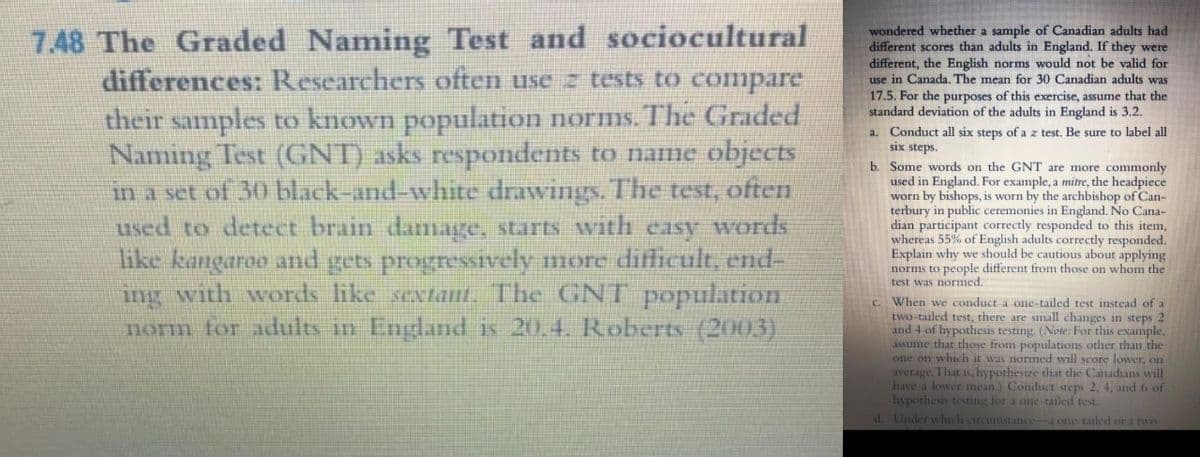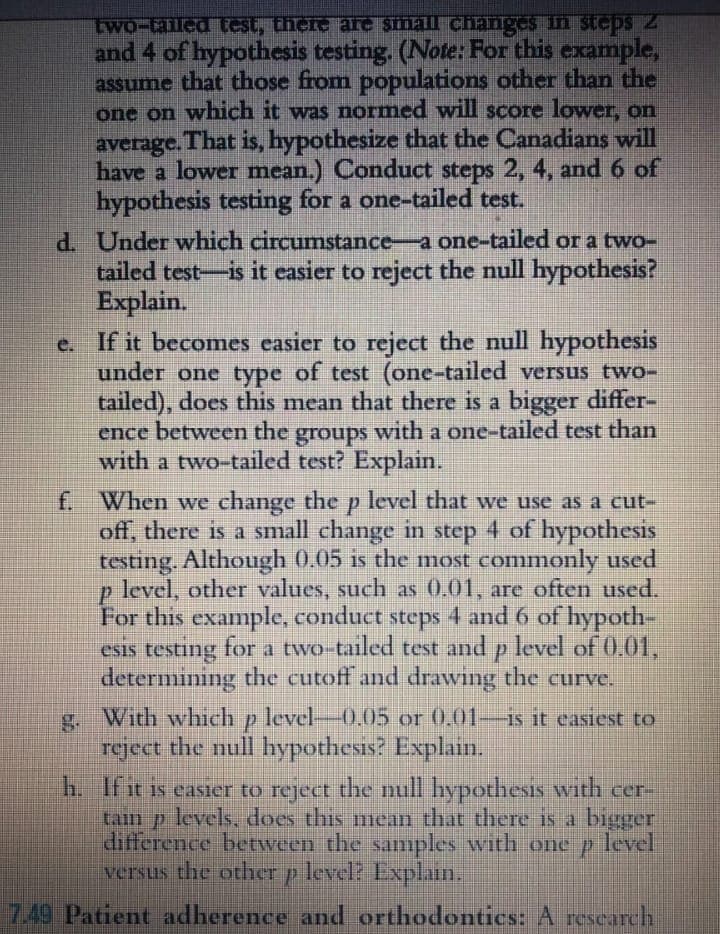d. Under which circumstance-a one-tailed or a two- tailed test-is it easier to reject the null hypothesis? Explain. e. If it becomes easier to reject the null hypothesis under one type of test (one-tailed versus two- tailed), does this mean that there is a bigger differ- ence between the with a one-tailed test than with a two-tailed test? Explain. groups f. When we change the p level that we use as a cut- off, there is a small change in step 4 of hypothesis testing. Although 0.05 is the most commonly used level, other values, such as (0.01, are often used. For this example, conduct steps 4 and 6 of hypoth- esis testing for a two-tailed test and p level of 0.01, determining the cutoff and drawing the curve.
d. Under which circumstance-a one-tailed or a two- tailed test-is it easier to reject the null hypothesis? Explain. e. If it becomes easier to reject the null hypothesis under one type of test (one-tailed versus two- tailed), does this mean that there is a bigger differ- ence between the with a one-tailed test than with a two-tailed test? Explain. groups f. When we change the p level that we use as a cut- off, there is a small change in step 4 of hypothesis testing. Although 0.05 is the most commonly used level, other values, such as (0.01, are often used. For this example, conduct steps 4 and 6 of hypoth- esis testing for a two-tailed test and p level of 0.01, determining the cutoff and drawing the curve.
Glencoe Algebra 1, Student Edition, 9780079039897, 0079039898, 2018
18th Edition
ISBN:9780079039897
Author:Carter
Publisher:Carter
Chapter10: Statistics
Section10.4: Distributions Of Data
Problem 19PFA
Related questions
Topic Video
Question
Answer part d,e,f
[typed ]

Transcribed Image Text:Naming Test and sociocultural
differences: Researchers often use z tests to compare
wondered whether a sample of Canadian adults had
different scores than adults in England. If they were
different, the English norms would not be valid for
use in Canada. The mean for 30 Canadian adults was
17.5. For the purposes of this exercise, assume that the
standard deviation of the adults in England is 3.2.
7.48 The Graded
their samples to known population norms. The Graded
Naming Test (GNT) asks respondents to name objects
in a set of 30 black-and-white drawings. The test, often
used to detect brain damagge, starts with casy words
like kangaroo and gets progressively more difficult, end-
ing with words like sextant. The GNT population
norm for adults in England is 20.4. Roberts (2003)
a. Conduct all six steps of a z test. Be sure to label all
six steps.
b. Some words on the GNT are more commonly
used in England. For example, a mitre, the headpiece
worn by bishops, is worn by the archbishop of Can-
terbury in public ceremonies in England. No Cana-
dian participant correctly responded to this item,
whereas 55% of English adults correctly responded.
Explain why we should be cautious about applying
norms to
people different from those on whom the
test was normed.
When we conduct a one-tailed test instead of a
two-tailed test, there are small changes in steps 2
and 4 of hypothesis testing. (Note: For this example,
assume that those from populations other than the
one on which it was normed will score lower, on
average. That is, hypothesize that the Canadians will
have a lower mean.) Conduct steps 2, 4, and 6 of
hypothesis testing for a one-tailed test.
d. Under which circumstancea one tailed or a two-

Transcribed Image Text:two-tailed test, there are small changes in SIGDS 2
and 4 of hypothesis testing. (Note: For this example,
assume that those from populations other than the
one on which it was normed will score lower, on
average. That is, hypothesize that the Canadians will
have a lower mean.) Conduct steps 2, 4, and 6 of
hypothesis testing for a one-tailed test.
d. Under which circumstance-a one-tailed or a two-
tailed test-is it easier to reject the null hypothesis?
Explain.
e. If it becomes easier to reject the null hypothesis
under one type of test (one-tailed versus two-
tailed), does this mean that there is a bigger differ-
ence between the with a one-tailed test than
groups
with a two-tailed test? Explain.
f. When we change the p level that wve use as a cut-
off, there is a small change in step 4 of hypothesis
testing. Although 0.05 is the most commonly used
level, other values, such as 0.01, are often used.
For this example, conduct steps 4 and 6 of hypoth-
esis testing for a two tailed test and p level of 0.01,
determining the cutoff and drawing the curve.
With whichp level-0.05 or 0.01-is it easiest to
reject the null hypothesis? Explain.
h. Ifit is easier to reject the null hypothesis with cer-
tam p levels, does this mean that there 15 a bigger
difference between the samples with one p level
versus the other p level? Explain.
7.49 Patient adherence and orthodontics: A rescarch
Expert Solution
This question has been solved!
Explore an expertly crafted, step-by-step solution for a thorough understanding of key concepts.
This is a popular solution!
Trending now
This is a popular solution!
Step by step
Solved in 2 steps with 1 images

Knowledge Booster
Learn more about
Need a deep-dive on the concept behind this application? Look no further. Learn more about this topic, statistics and related others by exploring similar questions and additional content below.Recommended textbooks for you

Glencoe Algebra 1, Student Edition, 9780079039897…
Algebra
ISBN:
9780079039897
Author:
Carter
Publisher:
McGraw Hill

Big Ideas Math A Bridge To Success Algebra 1: Stu…
Algebra
ISBN:
9781680331141
Author:
HOUGHTON MIFFLIN HARCOURT
Publisher:
Houghton Mifflin Harcourt

Glencoe Algebra 1, Student Edition, 9780079039897…
Algebra
ISBN:
9780079039897
Author:
Carter
Publisher:
McGraw Hill

Big Ideas Math A Bridge To Success Algebra 1: Stu…
Algebra
ISBN:
9781680331141
Author:
HOUGHTON MIFFLIN HARCOURT
Publisher:
Houghton Mifflin Harcourt